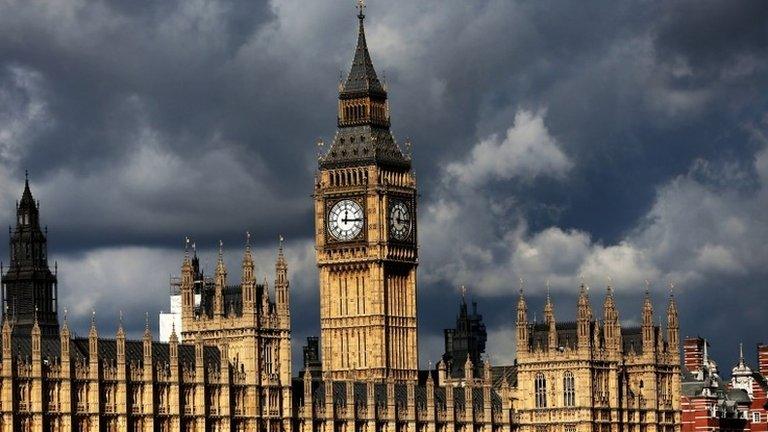The historical child abuse inquiries and what happens next
- Published

There have been claims for many years about paedophiles in powerful places and establishment attempts to cover-up their actions.
The government's principal probe - a sweeping, independent inquiry looking at how public bodies dealt with these types of allegations -ran into problems before it has even started work.
Meanwhile, there are several police investigations into historical allegations of abuse.
What sparked the inquiries and what happens next?

What are the allegations?
On 1 July last year, Labour MP Simon Danczuk called on Leon Brittan to say what he knew about paedophile allegations passed to him when he was home secretary in the 1980s. The files were given to Lord Brittan by the late Conservative MP Geoffrey Dickens, who was a long-standing campaigner against child abuse.
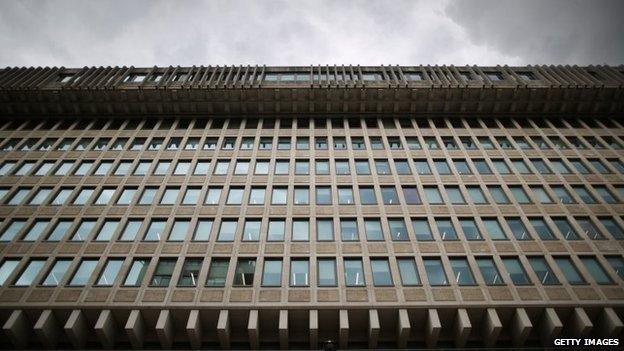
The Home Office's former building, now the Ministry of Justice
Mr Dickens's son has said the files - now missing - contained "explosive" paedophile allegations about powerful and famous figures, including politicians.
Since Mr Danczuk's comments brought the so-called "Dickens dossier" to the fore, the focus has moved to the wider issue of how historical child sex abuse allegations were dealt with by public bodies and other institutions across the country.
Previously there had been calls for an overarching investigation into historical abuse claims in the wake of revelations that Jimmy Savile abused hundreds of victims at hospitals, children's homes and schools.

Who in politics has been implicated?
Peter McKelvie, a former child protection manager, claims that at least 20 prominent figures - including former MPs and government ministers - abused children for "decades".
Former child protection manager Peter McKelvie says there is now a chance of justice for the victims of child abuse
Mr McKelvie discovered suggested links between paedophiles and the government while assisting police in investigating convicted paedophile Peter Righton. Among evidence seized from Righton's home in 1992 were a vast number of documents that pointed to a "very well organised paedophile network", going back to the 1950s and 1960s, according to Mr McKelvie.
When the Savile scandal broke, Mr McKelvie contacted Labour MP Tom Watson who raised the issue in the Commons in 2012.
As more information came in, different investigations were launched, they include:
The Metropolitan Police's Operation Fernbridge, which is investigating allegations of a network of abusers in the late 1970s and 1980s at the former Elm Guest House in Barnes, south-west London - the scene of alleged parties involving MPs and other members of the establishment
Greater Manchester Police are conducting a new investigation into allegations of abuse by Cyril Smith in Rochdale, including at Knowl View, a children's home which closed in 1994

Cyril Smith died in 2010 without ever being formally charged over the abuse claims against him

What other inquiries or investigations have been carried out or are ongoing?
28 NHS hospitals have published reports on allegations involving the late BBC DJ and presenter Savile. 13 other NHS organisations are still to report. A former judge is also looking into whether culture and practice at the BBC enabled Savile to carry out the sexual abuse of children
Operation Yewtree - set up following Savile's death in 2011 - has seen a string of high-profile entertainers being prosecuted for alleged sex crimes
At least 1,400 children were abused in Rotherham between 1997 and 2013, a report published in August 2014 found., external The report led to the resignation of senior council leaders and Shaun Wright, the police and crime commissioner for South Yorkshire
And local authorities have been instructed to investigate claims that Savile abused children at 21 children's homes and schools in England in the 1960s, 70s and 80s
Operation Cayacos, which is among numerous other ongoing historical child abuse investigations around the UK, is investigating allegations of a paedophile ring linked to Righton, a founding member of the Paedophile Information Exchange, a group that campaigned to make sex between adults and children legal
Operation Midland is investigating three alleged murders as part of an inquiry into historical child abuse. This investigation is under the umbrella of Operation Fairbank, which is looking into historical abuse

What did the "Dickens dossier" allege?
Press reports from the era claimed one file concerned a civil servant and that another one related to an employee of Buckingham Palace. The papers also contained allegations concerning the Paedophile Information Exchange.
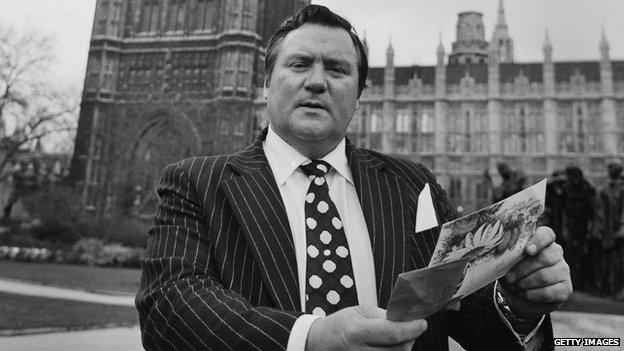
The allegations can be traced back to a dossier complied by campaigning MP Geoffrey Dickens
In an interview with the Daily Express in 1983, Mr Dickens said he had eight names of "really important, public figures" he was going to expose.
But former minister David Mellor has played down what he called the "Dickens dossier", saying: "It was a good publicity thing for him but there wasn't much substance behind it."

What happened to the files?
Lord Brittan, who died on 22 January this year, said he received a "substantial bundle of papers" from Mr Dickens and asked his Home Office officials to report back to him if "action needed to be taken". He had said any suggestion he acted inappropriately was "wholly without foundation".
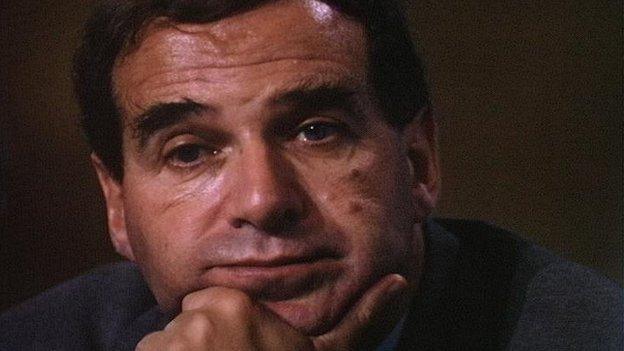
Leon Brittan was home secretary under Margaret Thatcher
After MP Tom Watson made allegations of a link between abuse and "Parliament and Number 10" in 2012, the Home Office carried out a review of hundreds of thousands of files, external to identify information about organised child abuse.
The review, covering the years 1979 - 1999, found 527 potentially relevant files the department had kept and a further 114 that were either missing, destroyed or "not found".
The department's top official Mark Sedwill says the 2013 review found no evidence that documents had been inappropriately destroyed.
Mark Sedwill: "I am concerned about all material that we can't find"
He told the Home Affairs Committee he was "concerned" over the missing files but MPs should "not assume there is anything sinister" in their absence.
Former minister Mr Mellor said the 114 unaccounted for Home Office files "have nothing to do with the Geoffrey Dickens case".
In November 2014, a review by NSPCC chief executive Peter Wanless found no evidence of organised attempts to conceal child abuse by the Home Office.

Where are the investigations heading?
The home secretary has announced an expert-led, independent inquiry into whether public bodies, such as the police, NHS and BBC, have failed in their duty of care, external to protect children from sexual abuse.
Home Secretary Theresa May: "With allegations as serious as these, the public needs to have complete confidence"
Theresa May has said this could be upgraded to a full public inquiry if the panel of experts, external leading it deem it necessary.
But the inquiry suffered an early setback after its chair, retired senior judge Elizabeth Butler-Sloss, stood down amid questions about her independence.
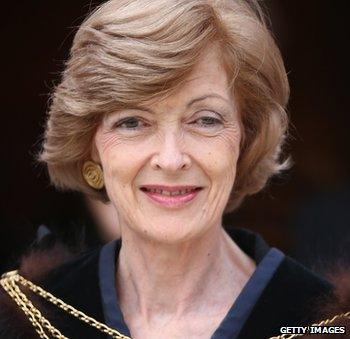
Dame Fiona Woolf was the second person chosen to head the probe
Baroness Butler-Sloss said she did not believe victims of abuse could have full confidence in her given that her late brother, Lord Havers, was attorney general for much of the 1980s and was the government's senior legal officer at the time the Dickens dossier was considered.
Home Secretary Theresa May then chose corporate lawyer Dame Fiona Woolf to replace her, but she also stood down after questions were raised over her experience and personal connections. Dame Fiona disclosed that she lived in the same street as Lord Brittan and had dinner with him five times between 2008 and 2012, although she said they did not have a "close association".
In February, Justice Lowell Goddard was named as the third head of the inquiry. Mrs May also announced that the inquiry would have statutory powers and a new panel.
Justice Goddard said she was "committed to leading a robust and independent inquiry".
- Published1 December 2015
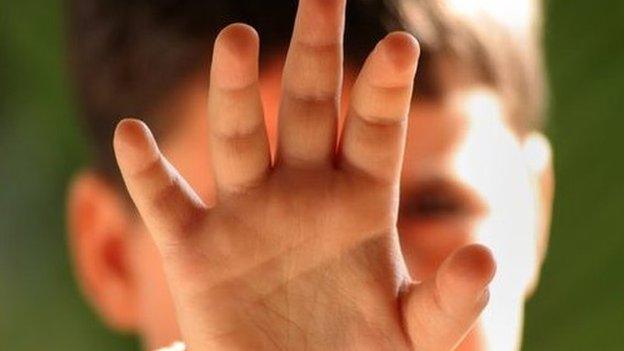
- Published22 January 2015
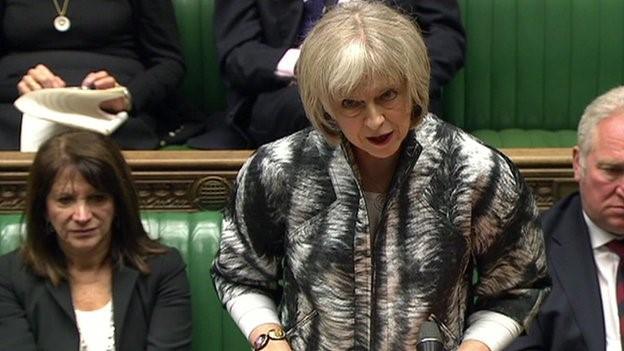
- Published20 January 2015
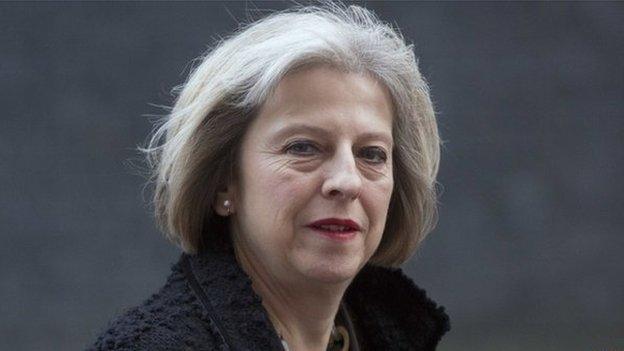
- Published22 January 2015
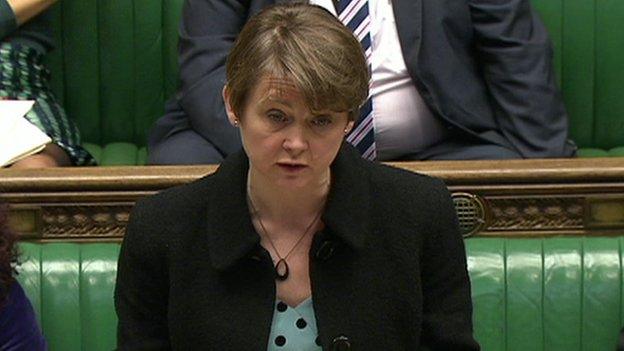
- Published4 February 2015
